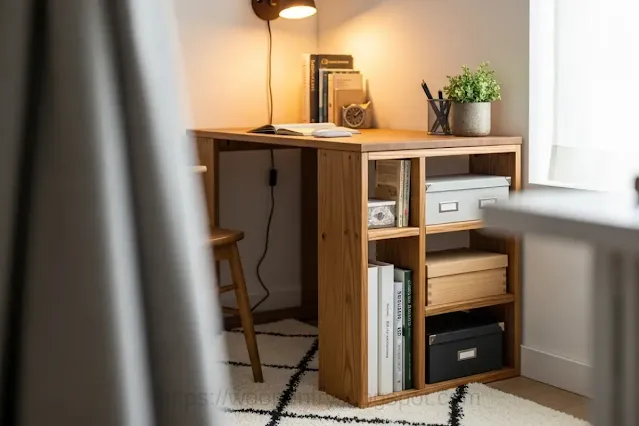Maximizing Productivity in Small Spaces: Wooden Desk Layouts That Work
 |
| Maximizing Productivity in Small Spaces |
Maximizing Productivity in Small Spaces
Why Wood Is Ideal for Small Desks: Wood remains one of the most versatile and aesthetic materials for home furniture. It blends easily with any interior style—from minimalist to rustic—and can be customized in size, finish, and function. Unlike plastic or metal, wood creates a calming and warm ambiance, which is essential when you're working in tight quarters. Additionally, many types of wood, such as birch or beech, are lightweight yet strong—ideal for small, movable desk units.Strategic Placement for Productivity:When space is tight, placement is everything. Placing your wooden desk near a natural light source, such as a window, not only boosts mood and reduces eye strain but also gives the illusion of more space. In studio apartments, the ideal location is often a corner near the window or against a long wall. Avoid placing desks in the middle of the room, as it can disrupt the flow of movement and make the space feel more crowded.
Built-In Storage to Eliminate Clutter: A cluttered workspace is the enemy of productivity, especially in small areas. Desks with built-in storage—like side drawers, under-desk shelves, or overhead cubbies—are a game changer. Custom wooden desks allow you to integrate storage directly into the design. Consider a vertical side shelf built into the desk leg or a small riser platform above the work surface to store stationery, books, and gadgets.
Foldable and Expandable Wooden Desk Options: Multifunctional furniture is a smart solution for small living spaces. A foldable wooden desk can be closed when not in use, freeing up space for other activities. Some desks offer expandable leaves or panels that provide additional workspace during busy hours and retract afterward. When choosing such a design, look for smooth hinges and sturdy joints made from quality hardwoods like maple or walnut.
Creating a Defined Work Zone Without Walls: One of the main challenges in open-plan or small living areas is separating the work zone from the rest of the space. Even if you can’t install partitions, you can use your wooden desk and accessories to define your workspace visually. Choose a desk in a contrasting color to your flooring or walls, and frame it with a rug or vertical shelving. Add a corkboard or framed artwork above the desk to further designate the zone.
Lighting for Small Wooden Workspaces: Lighting is crucial in maximizing small workspaces. While natural light is ideal, it’s not always available in every layout. For those tight spots, opt for wall-mounted or clamp-on LED lamps that don’t occupy desk space. Warm-toned lighting pairs beautifully with wooden desks and can help reduce screen glare and fatigue.
Floating Desks and Wall Units: Floating desks are ideal for very narrow rooms, hallways, or underused walls. These wall-mounted wooden units take up zero floor space and can be designed with folding tops or hidden compartments. Paired with a floating shelf or two above, they become compact yet highly functional work hubs. Choose a soft matte wood finish to blend the desk into your wall if you want a seamless look.
The Ergonomics of Compact Desks: Just because a desk is small doesn’t mean it should be uncomfortable. Pay attention to desk height and seating. Ideally, your wooden desk surface should sit at 28–30 inches high for proper posture. If you’re limited in space for a full ergonomic chair, look for small-scale task chairs with adjustable height and lumbar support. Comfort is key to maintaining productivity throughout the day.
Keeping Cables Under Control: In tight quarters, cable clutter can quickly take over. Look for wooden desks with built-in cable grommets or back panels to hide wires. You can also add adhesive cable organizers to the back or underside of your desk. For those who use multiple monitors or devices, a wooden riser with a built-in power strip underneath is a tidy and elegant solution.
Personalization and Minimal Decor:The last step to making your compact wooden workspace functional and inspiring is personalization. Avoid overdecorating, which can make small spaces feel cramped. Choose a few key decor elements—a ceramic pen holder, a plant in a wooden pot, or a framed print. Personalization should enhance productivity, not distract from it.
Recommended Types of Wood for Compact Furniture
Explore woods like bamboo, ash, birch, and engineered wood for their balance of strength and weight. Sustainability-conscious users may prefer reclaimed wood options, which add both character and eco-friendliness.
Combining Style and Sustainability in Small-Space Design
Opt for low-VOC finishes and sustainably sourced wood for an environmentally conscious desk setup. Combine modern aesthetics with traditional materials for a timeless, responsible design.

